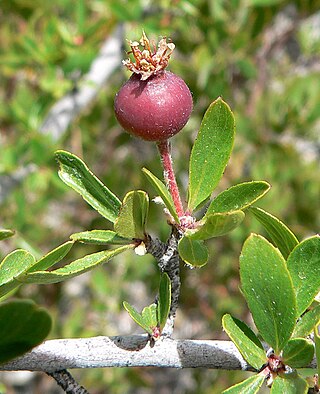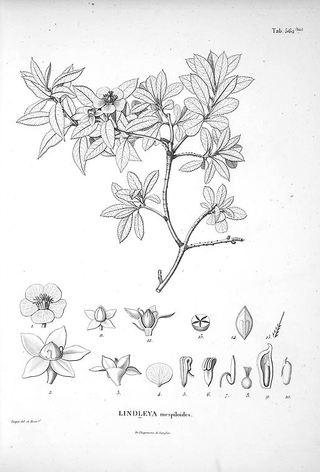
Rosaceae, the rose family, is a family of flowering plants that includes 4,828 known species in 91 genera.

The MaloideaeC.Weber was the apple subfamily, a grouping used by some taxonomists within the rose family, Rosaceae. Recent molecular phylogenetic evidence has shown that the traditional Spiraeoideae and Amygdaloideae form part of the same clade as the traditional Maloideae, and the correct name for this group is Amygdaloideae. Earlier circumscriptions of Maloideae are more-or-less equivalent to subtribe Malinae or to tribe Maleae. The group includes a number of plants bearing commercially important fruits, such as apples and pears, while others are cultivated as ornamentals.

Amygdaloideae is a subfamily within the flowering plant family Rosaceae. It was formerly considered by some authors to be separate from Rosaceae, and the family names Prunaceae and Amygdalaceae have been used. Reanalysis from 2007 has shown that the previous definition of subfamily Spiraeoideae was paraphyletic. To solve this problem, a larger subfamily was defined that includes the former Amygdaloideae, Spiraeoideae, and Maloideae. This subfamily, however, is to be called Amygdaloideae rather than Spiraeoideae under the International Code of Nomenclature for algae, fungi, and plants as updated in 2011.

The rose subfamily Rosoideae consists of more than 850 species, including many shrubs, perennial herbs, and fruit plants such as strawberries and brambles. Only a few are annual herbs.

In botany, a pome is a type of fruit produced by flowering plants in the subtribe Malinae of the family Rosaceae. Pome fruits consist of a central "core" containing multiple small seeds, which is enveloped by a tough membrane and surrounded by an edible layer of flesh. Pome fruit trees are deciduous, and undergo a dormant winter period that requires cold temperatures to break dormancy in spring. Well-known pomes include the apple, pear, and quince.

Sorbus is a genus of over 100 species of trees and shrubs in the rose family, Rosaceae. Species of Sorbus (s.l.) are commonly known as whitebeam, rowan, mountain-ash and service tree. The exact number of species is disputed depending on the circumscription of the genus, and also due to the number of apomictic microspecies, which some treat as distinct species, but others group in a smaller number of variable species. Recent treatments classify Sorbus in a narrower sense to include only the pinnate leaved species of subgenus Sorbus, raising several of the other subgenera to generic rank.

Photinia is a genus of about 30 species of small trees and large shrubs, but the taxonomy has recently varied greatly, with the genera Heteromeles, Stranvaesia and Aronia sometimes included in Photinia.

Chamaemespilus is a genus of shrubs in the family Rosaceae. It is monotypic, being represented by the single species Chamaemespilus alpina, commonly known as false medlar or dwarf whitebeam. It is native to the mountains of central and southern Europe, from the Pyrenees east through the Alps to the Carpathians and the Balkans, growing at elevations of up to 2500 m.

Stranvaesia is a genus of flowering plants in the family Rosaceae. Its morphology is so similar to Photinia that it has sometimes been included within that genus, but recent molecular data indicate that the two genera are distinct.

Mespilus, commonly called medlar, is a monotypic genus of flowering plants in the family Rosaceae containing the single species Mespilus germanica of southwest Asia. It is also found in some countries in the Balkans, especially in Albanian, North Macedonian and Bulgarian regions, and in western parts of Caucasian Georgia. A second proposed species, Mespilus canescens, discovered in North America in 1990, proved to be a hybrid between M. germanica and one or more species of hawthorn, and is properly known as × Crataemespilus canescens.

Pseudocydonia sinensis or Chinese quince is a deciduous or semi-evergreen tree in the family Rosaceae, native to southern and eastern China. It is the sole species in the genus Pseudocydonia. Its hard, astringent fruit is used in traditional Chinese medicine and as a food in East Asia. Trees are generally 10–18 metres (33–59 ft) tall.

Holodiscus is a genus of flowering plants in the family Rosaceae, native to the Americas, from southwestern British Columbia, Canada and the western United States south to Bolivia.

Purshia is a small genus of 5–8 species of flowering plants in the family Rosaceae which are native to western North America.

Peraphyllum is a monotypic genus of flowering plants in the rose family, containing the single species Peraphyllum ramosissimum, commonly known as wild crab apple.

Vauquelinia, commonly known as the rosewoods, is a genus of the rose family, Rosaceae. It consists of two species of shrubs found in the southwestern United States and northwestern Mexico. The genus was named for French chemist Louis Nicolas Vauquelin (1763-1829). The nectar provided by these plants is commonly fed on by wasps such as Polistes instabilis.

Gillenia is a genus of two species of perennial herbs in the family Rosaceae, Gillenia stipulata and Gillenia trifoliata. Common names for plants in this genus include: Bowman's root, Indian-physic, American ipecac. This genus is endemic to dry open woods with acidic soils in eastern North America. Both plants are subshrubs with exposed semi-woody branches and serrated leaves; the larger lower leaves are divided into palmately arranged leaflets. Plants bloom in May, June, or July; blooms are composed of five slender white petals which are loosely arranged and typically appear slightly twisted and limp as if they were wilted. The flowers mature into small capsules. G. stipulata and G. trifoliata are often planted as ornamentals and used in herbal medicine.

Lindleya is a genus of Mexican evergreen trees of the family Rosaceae, tribe Maleae. The sole species, Lindleya mespiloides, grows to a height of 6 metres (20 ft) and bears solitary white fragrant flowers in summer. The fruit are dry dehiscent capsules.

Malacomeles, or false serviceberry, is a genus of flowering plants in the Rosaceae. It is most closely related to Amelanchier, Peraphyllum, Crataegus, and Mespilus.

The Maleae are the apple tribe in the rose family, Rosaceae. The group includes a number of plants bearing commercially important fruits, such as apples and pears, while others are cultivated as ornamentals. Older taxonomies separated some of this group as tribe Crataegeae, as the Cydonia group, or some genera were placed in family Quillajaceae.

Malinae is the name for the apple subtribe in the rose family, Rosaceae. This name is required by the International Code of Nomenclature for algae, fungi, and plants, which came into force in 2011 for any group at the subtribe rank that includes the genus Malus but not either of the genera Rosa or Amygdalus. The group includes a number of plants bearing commercially important fruits, such as apples and pears, while others are cultivated as ornamentals.



















